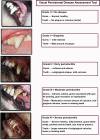A cross-sectional study to estimate prevalence of periodontal disease in a population of dogs (Canis familiaris) in commercial breeding facilities in Indiana and Illinois
- PMID: 29346448
- PMCID: PMC5773197
- DOI: 10.1371/journal.pone.0191395
A cross-sectional study to estimate prevalence of periodontal disease in a population of dogs (Canis familiaris) in commercial breeding facilities in Indiana and Illinois
Abstract
The objectives of this cross-sectional study were: 1) to estimate the prevalence and characterize the severity of periodontal disease in a population of dogs housed in commercial breeding facilities; 2) to characterize PD preventive care utilized by facility owners; and 3) to assess inter-rater reliability of a visual scoring assessment tool. Adult dogs (N = 445) representing 42 breeds at 24 CB facilities in Indiana and Illinois were assessed. Periodontal disease was scored visually using the American Veterinary Dental Collage 0-IV scale. Inter-rater reliability was assessed on 198 dogs and facility owners were asked to provide information about the preventive care utilized. The overall prevalence of periodontal disease (Grades I-IV) was 86.3% (95% CI: 82.9, 89.3). An ordered logistic regression analysis found age (OR = 1.4; 95% CI 1.24, 1.54; P<0.0001), facility (OR = 1.13; 95% CI 1.09, 1.18; P<0.0001), sex (OR = 1.7; 95% CI 1.12, 2.65; P = 0.013), and non-professional dental scaling (OR = 2.82; 95% CI 1.34, 5.91; P = 0.006) to be statistically significant. Inter-rater reliability analysis found agreement to be 86.2%, with a weighted kappa of 0.4731 (95% CI 0.3847, 0.5615) indicating moderate agreement. Risk of periodontal disease increased with increasing age. Additionally, a trend toward decreasing risk with increasing weight was also found, although it was not statistically significant. The trends identified agree with studies that have evaluated periodontal disease in the companion dog population and do not support the assumption that the dental health of dogs in commercial breeding facilities is worse than that of the population as a whole. Although there were few cases of severe periodontal disease and all facilities employed some type of preventive care in this sample, the large number of dogs with some degree of disease (Grades I-IV) suggests that further investigation of preventive care is warranted.
Conflict of interest statement
Figures
References
-
- Niemiec B. Periodontal Disease. Top Companion Anim Med. 2008; 23: 72–80. doi: 10.1053/j.tcam.2008.02.003 - DOI - PubMed
-
- Wiggs RB, Lobprise HB. Periodontology In:Veterinary dentistry, principals and practice: Philadelphia:Lippincott Raven; 1997. pp. 186–231.
-
- O′Neill DG, Church DB, McGreevy PD, Thomson PC, and Brodbelt DC. Prevalence of disorders recorded in dogs attending primary-care veterinary practices in England. PLoS ONE. 2014; 9(3): e90501 doi: 10.1371/journal.pone.0090501 - DOI - PMC - PubMed
-
- Diez M, Picavet P, Ricci R, Dequenne M, Renard M, Bongartz A, et al. Health screening to identify opportunities to improve preventive medicine in cats and dogs. J Small Anim Pract. 2015; 56: 463–469. doi: 10.1111/jsap.12365 - DOI - PubMed
-
- Kyllar M, Witter K. Prevalence of dental disorders in pet dogs. Vet. Med.-Czech. 2005; 11: 496–505.
Publication types
MeSH terms
LinkOut - more resources
Full Text Sources
Other Literature Sources



